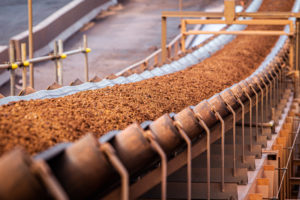
Anyone who works in material handling—or the process of moving, processing, and storing materials—knows how even a small issue can snowball into a bigger and more expensive problem. One machine breaks down, and production stalls. One ingredient spoils, and the entire batch is compromised.
What material handling issue gives you the biggest problems? What are some “quick fixes” that you can make that can make a big difference in production speed, quality, and cost? In this post, let’s look at how some companies improved their material handling system and its impact on their bottom line.
Frequent Downtimes
A US-based utilities company uses bituminous waste coal, a mining by-product, to produce clean energy. The thick material—which contains sandstone, clay, and moisture—had a tendency to cake in the feed chutes.
Workers had to enter the chutes to chip at the blocks. This occurred 15 times during each 12-hour shift, taking 20 minutes each time.
Manual cleaning caused downtime and increased labor costs. Workers were also unnecessarily exposed to dust, which can cause damage to the respiratory system through prolonged or repeated inhalation.
The company replaced manual cleaning with an AirSweep system. The AirSweep VA-51 can activate 6 to 8 feet in diameter of material and is effective even for heavy materials such as sandstone and clay.
After installing AirSweep, the plant no longer experienced plugging concerns in the feed chute. They experienced improved productivity and had lower energy costs compared to previous flow aids. “The AirSweep units paid for themselves within 2 weeks!” said the plant engineer.
Poor Product Uniformity
One of the world’s largest tire manufacturers uses carbon black to improve durability and performance. It conducts heat away from the tread and belt area and can reduce rolling resistance.
However, carbon black has a tendency to pack and leave deposits. Bridging above the hopper discharge caused frequent delays, and the material residue led to off-spec batches that had to be discarded.
The company tried fluidizers, but despite running continuously (and consuming a lot of plant air), these still left material residue.
AirSweep proved to be the more cost-effective solution for material handling efficiency. The system flushed away all carbon black residue and used less energy because the pulses were pulsed in a specific sequence and positioned at problem spots.
“AirSweep has provided us with reliable flow and reliable batch uniformity,” said the manufacturer’s engineering technology specialist.
Slow Loading Times
One of the biggest challenges of bulk material handling is loading the final product for transportation to the end-user.
For many years, a major distributor of granulated sugar with multiple locations across the United States had issues with unloading sugar from railcars. Sugar has a tendency to attract moisture, and cake or clump during storage.
The company tried industrial vibrators, which actually made the material more compact. Operators had no choice but to enter the car or do rodding. This affected loading times and worker safety.
Finally, the company found a faster and safer solution: AcoustiClean Sonic Horns. These devices focus sound energy that pushes material in a fast, steady flow. The horns were attached to the railcar’s top access hatch, so all workers had to do was open the hatch and the discharge gate.
Material Pile-Up
If equipment fails, any material that is being loaded or processed can overflow and lead to a material pile-up.
If that occurs, it can take hundreds of manhours just to clean up the mess. A concrete company that processes 250 tons of gravel per hour calculated that it would take 3 people at least 3 hours to shovel one ton. “We would have to shovel for days!”
To prevent the problem, the company installed DAZIC zero speed switches on their conveyor system. Once equipment runs outside of pre-set speed limits, the switches send an alarm to the operator to stop operations.
The DAZIC Zero Speed Switches used by Barnes Concrete cost less than $900 each, and have not broken down after more than a decade of use.
Can We Help You?
Small fixes can give big results. Your material handling system can be improved without very expensive investments or complicated installations and changes to your process. In fact, our AirSweep ROI calculator will show you how our system can actually help you save money, compared to your current flow aids.
Contact us and we’ll be happy to work with you to find a material handling solution and a customized ROI.






Comments are closed